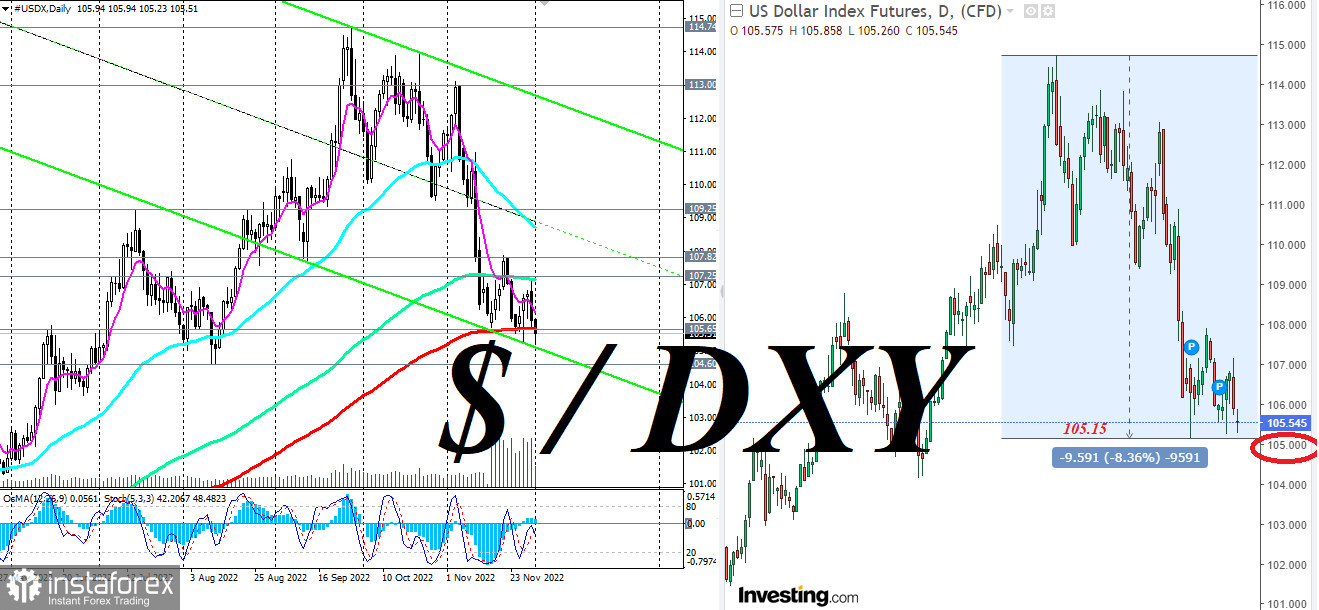
The dollar and its DXY index fell sharply Wednesday after Fed Chairman Jerome Powell cooled down excessive expectations of dollar bulls. Speaking at the Brookings Institution in Washington, Powell said that the US central bank could slow the pace of interest rate hikes as early as December. In his view, a slowdown at this stage is a good way to balance risks.
At the same time, Powell warned that the fight against inflation is far from over and key questions remain unanswered, including how high rates will eventually need to be raised and for how long—although the final rate is likely to be "somewhat above 4.6%." He also said that the Fed has already been "pretty aggressive" with its rate hikes and will not try to collapse the economy with further steep hikes just to get price growth under control faster.
Now, after these statements by Powell, the probability of a 50 basis point rate hike in December is estimated by market participants at 80%, according to CME Group.
Market participants are now waiting for latest data from the Department of Labor on the state of the US labor market (to be released Friday at 13:30 GMT) to get an idea of its strength. The state of the national labor market, together with data on GDP and inflation in the country are key factors in determining the Fed's monetary policy parameters.
As we noted in our previous review, NFP growth of 200,000, even though it was relatively down from the previous month, when +261K new jobs were created, is an acceptable figure for the Fed, indicating enough a stable state of the US labor market. According to various estimates, 150,000 new jobs should be added every month for the normal functioning of the US labor market.
However, the dollar may continue to decline if the US Department of Labor report disappoints investors. By the way, the ADP report published yesterday with data on the number of new jobs created in the private sector of the American economy fell short of the forecast: employment in November improved by 127,000 (against the forecast of 200,000 and the previous value of 239,000).
While there is no direct correlation between the ADP report and Non-Farm Payrolls, this report is often considered a precursor to official data from the US Department of Labor, and its weaker parameters may suggest a similarly weak report from the Department of Labor.
It is worth noting that market participants ignored Wednesday's positive report from the Bureau of Economic Analysis at the US Department of Commerce with revised data on US GDP in the 3rd quarter (+2.9% against the forecast of +2.7% and the previous indicator of +2.6%) and price indices, indicating an increase in prices and spending on personal consumption by Americans. This indicator (the Core Personal Consumption Expenditure Index, or the Core PCE Price Index, Core PCE) is the main measure of inflation that Fed officials use as the main indicator of inflation, and it still indicates rising inflation in the country.
As for the dollar and its DXY index, the near term prospect—the 105.00 support level on the DXY chart—is still standing and resisting a breakout. Economists say the 105.00 level should keep the dollar index from falling deeper, especially given concerns about the coronavirus in China, the ongoing geopolitical crisis in Europe and recession risks in the world's largest economies. In this situation, economists assume that the dollar should again win as a popular defensive asset.
Today, market participants will pay attention to the publication (from 13:30 to 15:00 GMT) of a whole block of important macro statistics for the United States. If it turns out to be positive, it will give dollar buyers a chance to take a breath. In the meantime, the dollar remains under pressure, also awaiting the publication on Friday of the official report on the US labor market for November.
 English
English 
 Русский
Русский Bahasa Indonesia
Bahasa Indonesia Bahasa Malay
Bahasa Malay ไทย
ไทย Español
Español Deutsch
Deutsch Български
Български Français
Français Tiếng Việt
Tiếng Việt 中文
中文 বাংলা
বাংলা हिन्दी
हिन्दी Čeština
Čeština Українська
Українська Română
Română

